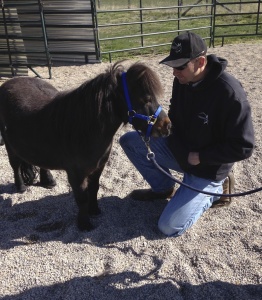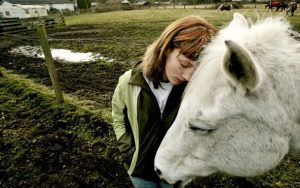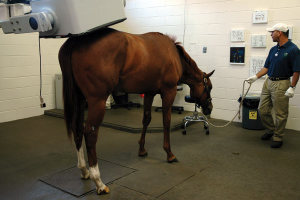By Lyle Barbour
South Mountain Equine
“My horse is limping, but not lame.”
 Defining the word lameness can be a confusing task, let alone actually defining a lameness on an individual horse. A common complaint an owner expresses to us while scheduling an appointment is “my horse is off.”
Defining the word lameness can be a confusing task, let alone actually defining a lameness on an individual horse. A common complaint an owner expresses to us while scheduling an appointment is “my horse is off.”
To me as a veterinarian that means the animal may be: lame, has a fever, is off of feed, ain’t doing right, off this planet, off putting behavior, or that he is a repellant to flies.
I then ask the owner to please describe, “What are you noticing with ‘Spotty’?”
A common reply includes: “He limps on his front leg every now and then, but doesn’t seem to be lame or sore anywhere.” This may bring up more questions than answers and has led me to try and define the word lameness in a general sense, similar to the common swear word, colic.
We all know that colic is simply defined as abdominal pain which in the real world doesn’t mean a whole lot, but refers to a whole lot. Abdominal pain can result from discomfort in the stomach, spleen, ovary, liver, large colon, kidney, etc., etc., etc. By including a large amount of possible problems in one basket (as with colic) we gain a general idea of what a client is noticing with their animal and then we can concentrate our efforts at a specific cause within that basket.
 The term ‘lameness’ can be defined in this vague but simple manner. We categorize a horse that is lame as a horse that shows an abnormality in its gait or the way it moves. This includes horses experiencing discomfort from navicular disease to arthritis and everything in between. It also includes those horses that are moving different (abnormal gait) due to a non-painful ailment such as muscle tightening due to an old injury. In the latter case, the animal moves abnormally and by definition is lame but is not actually in any discomfort or pain. We know now that we are evaluating a lame horse and our goals are now centered on finding the WHY is it lame.
The term ‘lameness’ can be defined in this vague but simple manner. We categorize a horse that is lame as a horse that shows an abnormality in its gait or the way it moves. This includes horses experiencing discomfort from navicular disease to arthritis and everything in between. It also includes those horses that are moving different (abnormal gait) due to a non-painful ailment such as muscle tightening due to an old injury. In the latter case, the animal moves abnormally and by definition is lame but is not actually in any discomfort or pain. We know now that we are evaluating a lame horse and our goals are now centered on finding the WHY is it lame.
By attempting to define the term lameness we can appreciate how difficult it may be to diagnose and treat an actual lameness case. When you have a veterinarian evaluate your horse for lameness it is very important to keep this fact in mind. A lameness evaluation may consist of myriad steps to finally end up with a diagnosis.
 Veterinarians begin each lameness exam with a systematic approach to ensure we don’t miss anything:
Veterinarians begin each lameness exam with a systematic approach to ensure we don’t miss anything:
- palpation of the limb
- physical examination
- hoof tester response
- flexion tests
- gait analysis
These are some of the early steps for your veterinarian. In some cases he or she may be able to pin point the abnormality or discomfort and begin further diagnostics and treatments. Many horses show lameness in a particular limb that has no external “red flags.” They don’t have joint or soft tissue swelling, heat, flexion abnormalities, or hoof tester response.
 Such horses may require further diagnostics such as nerve/joint blocks. In these cases, your veterinarian will inject a substance similar to what your dentist uses to numb your mouth, around the nerves or within a joint on the affected limb. This will make certain parts of the limb numb and will allow sensation in other regions. The procedure allows your horse to “tell” your veterinarian the region of soreness.
Such horses may require further diagnostics such as nerve/joint blocks. In these cases, your veterinarian will inject a substance similar to what your dentist uses to numb your mouth, around the nerves or within a joint on the affected limb. This will make certain parts of the limb numb and will allow sensation in other regions. The procedure allows your horse to “tell” your veterinarian the region of soreness.
For example, if your horse is 3/5 lame (obviously limping at a trot in a straight line) in the left forelimb and he “blocks” out (moves comfortable after the painful area is numb) to the heel region on that limb, then the discomfort is in that region that is numb. We now know the where, but not yet the what. Check out the 1-5 lameness scale here.
Further diagnostics are required at this point to evaluate the anatomy of the known sore region. This may include imaging via x-rays or  ultrasound. In certain cases, more in depth imaging may be required such as MRI or nuclear scintigraphy.
ultrasound. In certain cases, more in depth imaging may be required such as MRI or nuclear scintigraphy.
As you can see it may be a patience-building process from start to finish. A lameness evaluation may take 10 minutes or it may take days. The take home message: It may be difficult and costly to fully understand the where, what, and how to treat on any individual case. As with colic, the word lameness encapsulates hundreds of possible culprits and requires a collaborative effort from you as the owner and your veterinarian.
